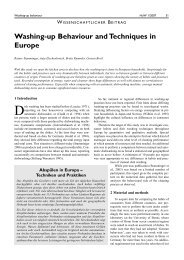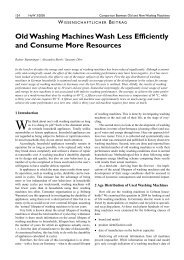Development of a novel mechatronic system for mechanical weed ...
Development of a novel mechatronic system for mechanical weed ...
Development of a novel mechatronic system for mechanical weed ...
Create successful ePaper yourself
Turn your PDF publications into a flip-book with our unique Google optimized e-Paper software.
Results and discussion<br />
102<br />
5.3.6 Methodology <strong>for</strong> evaluation <strong>of</strong> the algorithm <strong>for</strong><br />
online control <strong>of</strong> the hoeing tool<br />
For the controlling <strong>of</strong> the hoeing tool’s rotational speed, a VI was developed<br />
based on the algorithm presented in the previous chapter and implemented<br />
together with the VI-s <strong>for</strong> plant centre position detection in a final s<strong>of</strong>tware<br />
solution.<br />
After the hoeing, the controlling VI generates a report file containing in<strong>for</strong>mation<br />
about TRUE/FALSE values measured with sensors <strong>for</strong> plant detection,<br />
estimated <strong>for</strong>ward speed, position <strong>of</strong> the last recognised plant, calculated<br />
rotation speed and angular position <strong>of</strong> the hoeing tool <strong>for</strong> every sampling step.<br />
For graphical analysis <strong>of</strong> the acquired data an M-file in Matlab was written. This<br />
function provide automatic graphical interpretation <strong>of</strong> the data from the report<br />
file, creating three graphs: the first contains the <strong>for</strong>ward speed <strong>of</strong> the carrier and<br />
the rotational speed <strong>of</strong> the hoeing tool; the second contains angular positions <strong>of</strong><br />
the hoeing tool and estimated centre positions <strong>of</strong> detected plants; and the third<br />
contains the positions at which plants have been detected. In the second graph<br />
positions under the soil surface are particularly pointed out <strong>for</strong> each duckfoot<br />
knife.<br />
Quantitative evaluation <strong>of</strong> the hoeing accuracy can be done when distances<br />
between the hoeing tool blades under the soil surface and nearest plant middle<br />
position are known. The analysis can be classified in two groups: the duckfoot<br />
knife trajectories approaching the plants from the front side and duckfoot knife<br />
trajectories approaching the plants from the rear side. In the hoeing strategy<br />
with three cuts between plants, as described in chapter 5.3.3, duckfoot knife<br />
number 3 always approaches the plant from the front and duckfoot knife<br />
number 1 from the rear. The distance between the hoeing tool blade and the<br />
centre position <strong>of</strong> the plant can be calculated as:<br />
R = z + x (5.25)<br />
2 2<br />
front front front<br />
R = z + x (5.26)<br />
2 2<br />
rear rear rear





